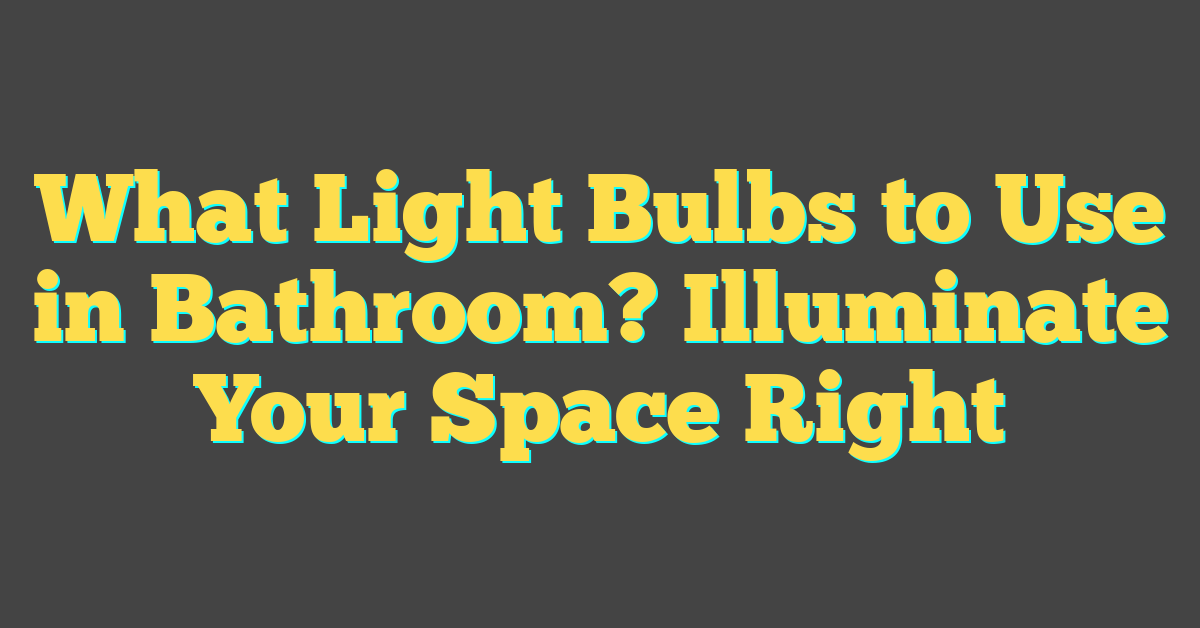Choosing the right light bulbs for your bathroom isn’t just about brightness; it’s about setting the mood, ensuring safety, and maximizing functionality. Whether you’re applying makeup or winding down with a relaxing bath, the proper lighting can make all the difference.

Importance of proper lighting in the bathroom
You’ve probably noticed how the right lighting can transform a room. The bathroom, especially, demands careful consideration as it serves various purposes throughout your day. It’s where you prep for the day ahead and unwind before bedtime. Good lighting is crucial—not only does it aid in routine tasks like shaving or makeup application, but it also greatly affects your room’s ambiance.
Task Lighting: A Necessity for Daily Routines
When focusing on task lighting, you’re looking at illuminating areas where you’ll perform daily grooming tasks. The vanity, for instance, requires bright, shadow-free light. Consider LED bulbs for their efficiency and long lifespan. Here’s a breakdown of suitable choices:
- For makeup application: Natural daylight equivalent bulbs with a Color Rendering Index (CRI) of 90 or above.
- For general grooming: LEDs with a color temperature of 2700K to 3000K for a warm, inviting glow.
Mood and Ambiance: Setting the Right Tone
Bathrooms aren’t just functional spaces; they’re also retreats. Lighting can set the stage for a relaxing bath after a long day. Dimmer switches are your friends here, giving you control over the intensity of light. Soft, warmer lights (around 2500K) create a cozy atmosphere, perfect for a laid-back soak. Remember to choose bulbs labeled “dimmable” when shopping.
Safety First: Preventing Accidents
Safety should always be a priority. Non-slip mats and sturdy handrails are essential, but so is proper lighting. Areas like the shower require waterproof fixtures. LEDs again come out on top for their brightness and minimally generated heat. Ensure there’s enough light to navigate safely without glare that can be disorienting.
By thoughtfully selecting the right light bulbs for each function, you blend form with function. Your bathroom becomes not just a room, but a personalized space that caters to your comfort, safety, and style. Enjoy the transformation as you apply these insights; your DIY projects and passion for lighting come together to breathe new life into an often underrated space.
Factors to consider when choosing light bulbs for the bathroom

When it’s time to pick out the light bulbs for your bathroom, several factors will guide your decision. You want to ensure that your choices provide functionality, efficiency, and contribute to the overall design aesthetic.
Brightness Levels are pivotal in a bathroom. Measured in lumens, it’s essential to choose a bulb that offers enough light for your tasks but isn’t blindingly bright. A range between 500 to 1600 lumens per bulb is a good benchmark, especially for vanity lighting where precision tasks are done.
Color Temperature plays a significant role in how your bathroom feels. Bulbs come with different color temperatures, shown in Kelvins (K). For a bathroom, you’ll typically want a warm light for a cozy glow or a cool light that resembles natural daylight. Cooler temperatures (between 3000K and 5000K) are ideal for tasks, while warmer ones (around 2700K) suit ambient lighting.
Remember, the Size and Shape of the bulb can determine whether it fits well with your fixtures. Bulbs like A19 are standard for most purposes, but G25 or globe bulbs may be more suited for vanity lights.
Another critical aspect is Energy Efficiency. LED bulbs use much less energy than traditional incandescent bulbs and have a longer lifespan. Not only do they save money in the long run, but they also reduce the need for frequent bulb changes.
Let’s not overlook Dimmability. Many people favor the flexibility of adjusting light intensity. For this purpose, make sure you select bulbs and fixtures that are compatible with dimmer switches.
Lastly, bear in mind Safety Ratings. In a space with high moisture levels, you’ll want bulbs that are rated for damp or wet conditions to avoid hazards and ensure the longevity of your lighting.
Each of these factors requires careful consideration to tailor the lighting to your specific needs and preferences in the bathroom. By paying attention to these details, you can expertly illuminate your space with the perfect bulbs that offer functionality, safety, and beauty.
Understanding the different types of light bulbs
« Are Light Bulbs Ohmic? Unveiling the Shocking Truth About Your Home Lighting
Can You Use a Regular Light Bulb in an Oven? The Safety Truth Revealed »

Before you dive into swapping out those old bulbs, you’ve got to know what’s out there. Light bulb technology has evolved dramatically, offering you an array of choices, each with its own benefits for your bathroom ambiance and functionality.
First up, we have incandescent bulbs. They’re the old school ones you’re probably most familiar with. They offer a warm glow and are often less expensive upfront. However, they’re not the most energy-efficient kids on the block, and they tend to have a shorter lifespan compared to other types.
Then there’s compact fluorescent lamps (CFLs). These guys give you a punch of bright light with a fraction of the energy you’d use with incandescents. They last longer, too. But be mindful, CFLs take a moment to warm up and reach full brightness. Plus, they contain a small amount of mercury, so you’ll need to dispose of them properly.
Light emitting diodes (LEDs) are the tech-savvy bulbs. They come with a higher initial price tag, but they’ll save you money in the long run due to their low energy usage and long lifespan. They’re also available in a range of color temperatures, making them a versatile choice for your bathroom.
Don’t forget about halogen bulbs—they’re similar to incandescents but are more energy-efficient and provide a brighter, white light. Just keep in mind that they can run hot, so they’re not ideal for every bathroom setting.
Lastly, there’s a newer player in town: smart bulbs. These innovative lamps can change colors, be controlled via your smartphone, or programmed to a schedule. Integrating smart bulbs in your bathroom can add convenience and a touch of luxury.
Choosing the right bulb requires a balance of aesthetics, function, and efficiency. Here’s a quick cheat sheet to help:
- Incandescent Bulbs: Warm glow, less expensive, less efficient
- CFLs: Energy-saving, bright light, contain mercury
- LEDs: Long-lasting, low energy use, higher initial cost
- Halogen Bulbs: Bright white light, more efficient than incandescents
- Smart Bulbs: Color changing, smartphone control, luxurious
Recommended light bulb options for bathroom lighting

Now that you’re well-versed in the different types of bulbs, let’s focus on the top picks for your bathroom oasis. Your bathroom isn’t just a functional spot—it’s a retreat, and choosing the right bulb can transform the experience.
LED Bulbs: A go-to choice for most homeowners, LED lights offer impressive longevity and energy efficiency. With a range of color temperatures, they can evoke a warm, inviting feel or a bright, daylight vibe.
- Energy efficiency saves on bills
- Long-lasting, reducing frequent replacements
- Available in dimmable options to set the mood
Halogen Bulbs: Should you desire a sparkle akin to sunlight for tasks like makeup or shaving, halogens closely mimic natural light. Keep in mind they generate more heat and may not be as energy-efficient as LEDs.
- Excellent color rendering properties
- Instant brightness with no warm-up time
- Typically more affordable upfront than LEDs
Smart Bulbs: Embrace the future with smart bulbs. You can control these from your phone or through voice-activated devices. Schedule lighting for ambience or security—even when you’re not home.
- Personalize settings for different scenarios
- Connect to other smart home devices
- Features may include adjustable colors and temperature
Remember, the wattage isn’t a concern with modern bulbs; it’s all about lumens. Brightness matters in your bathroom, especially around mirrors. For general bathroom use, aim for about 500 to 700 lumens per bulb. Here’s a quick guide on what to expect:
| Bulb Type | Lumens | Watts (Equivalent) |
|---|---|---|
| LED | 500 – 700 | 6 – 9W |
| Halogen | 500 – 700 | 40 – 50W |
| CFL | 500 – 700 | 9 – 13W |
As you illuminate your bathroom, consider the placement of fixtures and the purpose of each light source. Task lighting should be free of shadows and glare, whereas ambient lighting requires a softer touch to maintain a relaxing atmosphere. Adopting an approach that combines both aesthetics and functionality will ensure your bathroom shines in the best light possible.
Best practices for bathroom lighting

When illuminating your bathroom, layering is key. Think of layering light in the same way you’d layer clothing. You start with the basics and then add pieces for comfort, style, or functionality. In lighting terms, you’ve got your ambient lighting, which provides the overall illumination of the space. This can come from ceiling-mounted fixtures or recessed lighting.
Next is task lighting. For activities like shaving or applying makeup, you’ll want to ensure there are no shadows or glares. Vertical fixtures or sconces mounted on either side of the mirror are ideal for this purpose. Typically, they should be at eye level to cast even light across your face.
For additional flair and to highlight certain aspects of your bathroom, accent lighting can be employed. This can be in the form of track lighting directed at artworks or LED strips under a vanity for a modern touch.
When choosing bulbs for these layers:
- Go for LEDs or halogens for brighter, more efficient task lighting.
- For ambient lighting, LEDs provide a cost-effective, long-lasting solution that can mimic natural daylight.
- Use smart bulbs for accent lighting to easily adjust the mood or color temperature.
Remember the importance of Color Rendering Index (CRI). A higher CRI value (closer to 100) means better color differentiation, which is crucial for tasks that require precision like makeup application or wound care. As a guide:
| Bulb Type | Suggested CRI |
|---|---|
| LED | 90+ |
| Halogen | 100 |
| CFL | 80+ |
Remember, the bathroom’s humidity levels need special consideration. Always choose bulbs and fixtures rated for wet or damp locations to ensure longevity and safety.
And don’t forget dimmer switches. They’re not just for setting a relaxing mood. They also provide the flexibility to adjust brightness based on the time of day or task at hand.
Proper bathroom lighting fuses functionality with aesthetics. With the right setup, you’ll not only see everything more clearly, but you’ll also elevate the look of your space. Keep in mind that the best lighting plan is one that can adapt to all your activities and enhance the overall design of your bathroom.
Conclusion
Choosing the perfect light bulb for your bathroom isn’t just about brightness; it’s about creating a space that’s both functional and inviting. Remember to layer your lighting to achieve the best effect and select bulbs that match the task at hand—LEDs for longevity and halogens for a crisper light. Don’t overlook the CRI when precision is key and always opt for wet or damp rated fixtures to ensure safety. With smart bulbs, you can adjust the mood as you please, making your bathroom not just a room but an experience. Let your lighting reflect your personal style and elevate your bathroom’s design to the next level.
Frequently Asked Questions
What is the importance of proper bathroom lighting?
Proper bathroom lighting is crucial for functionality and aesthetics. It ensures safety, makes grooming tasks easier, and enhances the overall design of the space.
What are the different types of light bulbs suitable for bathrooms?
Suitable light bulbs for bathrooms include incandescent bulbs, compact fluorescent lamps (CFLs), light emitting diodes (LEDs), halogen bulbs, and smart bulbs, each with its own benefits and drawbacks.
What should be considered when choosing a light bulb for the bathroom?
When choosing a light bulb for the bathroom, consider factors like aesthetics, function, efficiency, Color Rendering Index (CRI), and whether the bulb is rated for wet or damp locations.
What are the best practices for bathroom lighting?
Best practices for bathroom lighting include layering light with ambient, task, and accent lighting, choosing LEDs or halogens for task lighting, LEDs for ambient lighting, and smart bulbs for adjustable accent lighting.
Why is the Color Rendering Index (CRI) important in bathroom lighting?
The Color Rendering Index (CRI) is important in bathroom lighting because it affects how accurately colors are viewed, which is vital for tasks that require precision, like applying makeup or shaving.
Can any bulb be used in the bathroom, or are there specific types?
Not all bulbs are suitable for bathroom settings. It’s crucial to choose bulbs and fixtures specifically rated for wet or damp locations to ensure safety and durability.
Are dimmer switches recommended for bathroom lighting?
Yes, dimmer switches are recommended for bathroom lighting as they offer flexibility in adjusting brightness to suit different moods and functions throughout the day.




